One of the biggest things I've struggled with in the past few years has been the notion of creating a space for computing. Over the years, since the tail end of high school, I have always had a particularly good space for doing computer. In high school it was a desk that was big enough to accommodate my desktop, my laptop, and my paper-based homework and other projects. At the university, the space was constrained just a little bit, but there was always enough room to have a desktop set up and either my laptop, or my paper-based homework.
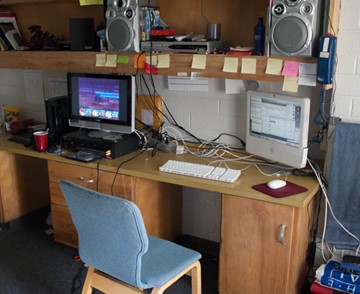
Often, there was enough room for both, and of course there was the few years where my ThinkPad T400 was my main computer, and I set it on a docking station when I got home.
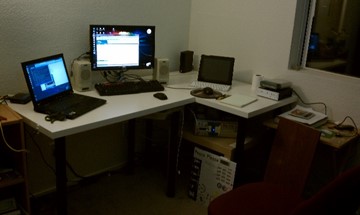
When I moved off-campus, I had to go buy my own desks, and had good luck with a pair of inexpensive IKEA desks set next to one-another, but that luck ran out when I moved into the Crazyhouse and found out that there was simply no place in the room I had where I could set both desks next to one-another, at least not in any type of configuration I was comfortable with. I did have a short bookshelf next to my desk, which was good for housing laptops or setting oft-used items such as boxes of rewriteable discs, but it was poor for using laptops. Although, in the garage I wasn't able to put them in an L formation, the hard floors meant I could roll around easily and I did have both tables next to one-another.
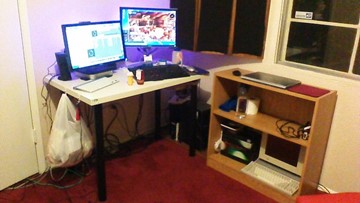
Now that I've moved to Julie's house, I have both desks next to one-another, and the question of how to create a desirable space for computing has come up again. I can now set both of my desks next to one another, but that doesn't seem to be recreating the "this is very nice" feeling I got about my setups on-campus and in my apartment.
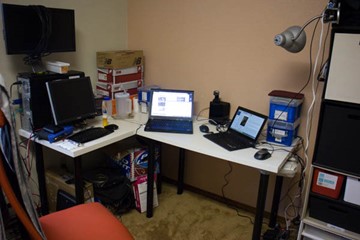
There are two factors or problems that I've identified so far: The first is that I currently don't have a good stationary computer. When I got superslab, I still had flatdell around for large projects, and even when flatdell was no longer around, I had a SunRay 1G thin client connected to a virtual machine on TECT in order to do things like run iTunes, leave Office documents open, and work on longer-term projects such as downloading files. Today, I have a pair of laptops, but neither of them is the one that I've universally declared as the home-base computer, and as such, neither of them has a monitor connected to it. The result is that my workspace gets a little too cluttered, because I'm not willing to hide anything away, for fear I'll need to dig it out tomorrow when I take that computer out into the field again.
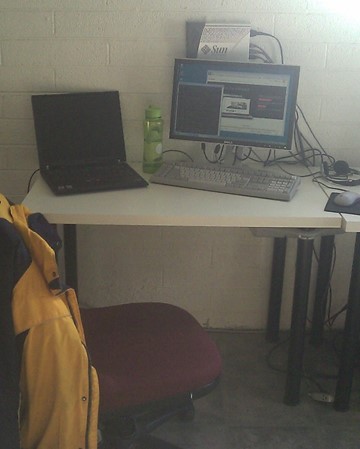 The other thing I think preventing my full appreciation of the space I've got available is that it is also cluttered by boxes an underneath the sideboard desk is completely filled with boxes that previously lived in the garage.
The other thing I think preventing my full appreciation of the space I've got available is that it is also cluttered by boxes an underneath the sideboard desk is completely filled with boxes that previously lived in the garage.
In the coming months as I continue throwing away stuff I don't need and clearing out more space (as well as bringing more of my own things into the room, I still have a bookshelf sitting in Julie's dining room, for example) then I'll be working toward cleaning up the desk and ensuring that its purpose stays clearly focused on housing computing equipment and projects. I think the addition of my bookshelf to the room and moving some of the other things I've got near the desks around will help a lot, especially in that it'll let me keep my Really Useful Boxes of optical disks off the actual desk surface.
The computer is a more interesting question. I have Topham, which is a terrible computer but does meet the requirements of being a desktop, and I could permanently connect one of my laptops to a keyboard/monitor/mouse, but those things don't necessarily lend themselves to a machine that itself can create the space.
And with that in mind, I've been looking at different types of "desktop" (or at least primarily stationary) computers with an eye toward creating a space.
One of the types of machines I've been looking at is modest all-in-one computers such as the Dell Inspiron 20/23, OptiPlex 3011 and 9020 AIO, and the XPS 18. These machines aren't particularly high end, but they can all take eight gigs of ram and would be capable of running a lot of software at once, and a quick game of World of Warcraft. They also all have reasonably good displays, with the XPS 18 in particular featuring a 1920x1080 display with an IPS panel, which would be particularly good for the photo management tasks I'd want to do with the machine.
However, these types of machines are low on computing horsepower (as already mentioned) and also low on connectivity. One of my biggest problems with the laptops is that I have external hard disks running every which-a-way, and if also want to connect my blu-ray burner, my web cam (which I use mainly as a microphone) and my mouse, I've got the better part of a powered 7-port hub populated to connect all of these things. The XPS 18 only has two USB ports, and they stick out the side. The XPS 18 would also need USB Ethernet or for me to use wireless. It's the kind of machine that would look really stylish on some people's home office desks, but I've got too much stuff going on. Even the Inspiron 20 only has three or four USB ports, although that machine has the benefit of having them on the back and having built-in Ethernet.
But, because of lessons learned with superslab and eisbrecher (namely that paying for a computer you like and has a lot of excess horsepower pays in the long run) I'm looking for more than just "okay."
Creating a space in this way is more than just about having a lot of computing horsepower and having a pretty setup, although those things play very well into it. Unlike when I was a student when most of my face-time with superslab was in classes or generally when I was away from home, most of my use today is when I'm at home sitting at my desk, or at work sitting at my desk, where I primarily use my powerful work computer anyway. In those days, it made sense to have a desktop that was evenly matched with the laptop, and it was okay for it to be a bit slower, as its main purpose was to be a home base.
This time around, the desktop is not only defining the space, but it is the new main computer, and as such, I expect it to have fewer problems competing with laptops for resources such as physical space, outlets, network jacks, and peripherals.